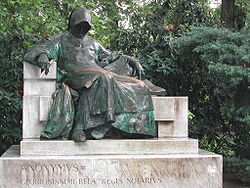
Anonymus (chronicler)
Encyclopedia

King of Hungary
The King of Hungary was the head of state of the Kingdom of Hungary from 1000 to 1918.The style of title "Apostolic King" was confirmed by Pope Clement XIII in 1758 and used afterwards by all the Kings of Hungary, so after this date the kings are referred to as "Apostolic King of...
, probably Béla III
Béla III of Hungary
Béla III was King of Hungary and Croatia . He was educated in the court of the Byzantine Emperor Manuel I who was planning to ensure his succession in the Byzantine Empire till the birth of his own son...
. Little is known about him, but his latinized name began with P, as he referred to himself as "P. dictus magister". Some scholars suggest that he was Péter, the bishop of Győr
Gyor
-Climate:-Main sights:The ancient core of the city is Káptalan Hill at the confluence of three rivers: the Danube, Rába and Rábca. Püspökvár, the residence of Győr’s bishops can be easily recognised by its incomplete tower. Győr’s oldest buildings are the 13th-century dwelling tower and the...
.
Anonymus is most famous for his work Gesta Hungarorum
Gesta Hungarorum
Gesta Hungarorum is a record of early Hungarian history by an unknown author who describes himself as Anonymi Bele Regis Notarii , but is generally cited as Anonymus...
("The Deeds of the Hungarians"), written in Latin around 1200. This work provides the most detailed history of the arrival of the Hungarians to the Carpathian Basin , although historians don't accept his work as authentic. Most of his attempts to explain the origin of several Hungarian place names are unsupported by modern etymology. The names of the seven chieftains of the Hungarians
Seven chieftains of the Magyars
The Seven chieftains of the Magyars were the leaders of the seven tribes of the Hungarians at the time of their arrival to the Carpathian Basin in 895 AD. Constantine VII, emperor of the Byzantine Empire names the seven tribes in his De Administrando Imperio, a list that can be verified with names...
are known from his writings.
The only surviving manuscript is from the 13th century and is in the National Széchényi Library
National Széchényi Library
The National Széchényi Library is a library in Budapest, Hungary. It is one of the two Hungarian national libraries, the other being the University of Debrecen Library.-History:...
in Budapest
Budapest
Budapest is the capital of Hungary. As the largest city of Hungary, it is the country's principal political, cultural, commercial, industrial, and transportation centre. In 2011, Budapest had 1,733,685 inhabitants, down from its 1989 peak of 2,113,645 due to suburbanization. The Budapest Commuter...
. It has been translated to Hungarian
Hungarian language
Hungarian is a Uralic language, part of the Ugric group. With some 14 million speakers, it is one of the most widely spoken non-Indo-European languages in Europe....
by István Lethenyey, canon of Pécs
Pécs
Pécs is the fifth largest city of Hungary, located on the slopes of the Mecsek mountains in the south-west of the country, close to its border with Croatia. It is the administrative and economical centre of Baranya county...
(1791), István Mándy (1799) and Károly Szabó (1860).
It is known from his Gesta Hungarorum that he was from the upper Tisza
Tisza
The Tisza or Tisa is one of the main rivers of Central Europe. It rises in Ukraine, and is formed near Rakhiv by the junction of headwaters White Tisa, whose source is in the Chornohora mountains and Black Tisa, which springs in the Gorgany range...
region and was tightly connected to the Aba family
Aba (family)
Aba is the name of a Genus Aba in the Kingdom of Hungary. Their ancestors may have been among the tribal leaders of the Kabars...
of that region. In the preface, he wrote that he studied in Western Europe (probably Paris
Paris
Paris is the capital and largest city in France, situated on the river Seine, in northern France, at the heart of the Île-de-France region...
), where he learned the genre in which he wrote his Gesta.

